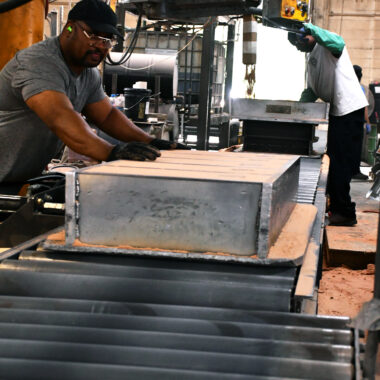Checking out the Craft: All About Aluminum Casting Techniques
Wiki Article
Crafting Excellence: Just How to Achieve High-Quality Light Weight Aluminum Castings Every Single Time
In the realm of aluminum spreading, the quest of excellence is a continual trip that requires a careful strategy and an eager understanding of the ins and outs entailed. Attaining consistent high-quality aluminum spreadings requires a thorough understanding of the procedures, from picking the ideal alloy to carrying out accurate mold layouts and meticulously managing spreading parameters.Comprehending Aluminum Spreading Processes
Light weight aluminum casting procedures, necessary in the production sector, include the complex makeover of molten aluminum into solid kinds via a series of carefully regulated actions. Understanding these procedures is vital to achieving top quality light weight aluminum spreadings constantly - about aluminum casting. The key methods utilized in light weight aluminum spreading are die casting, sand spreading, and investment spreading
Each of these procedures has its benefits and is picked based on variables like intricacy, quantity, and wanted finish of the aluminum spreading. about aluminum casting. Understanding the ins and outs of these methods is crucial for manufacturers aiming to create top quality aluminum castings constantly
Choosing the Right Light Weight Aluminum Alloy
Selecting the appropriate light weight aluminum alloy is a crucial choice in the manufacturing of high-quality aluminum spreadings. When selecting a light weight aluminum alloy for casting, it is vital to consider the specific demands of the application to make certain optimum performance.One of the most generally used light weight aluminum alloys for spreading is A356 - about aluminum casting. For applications calling for high toughness, 7075 light weight aluminum alloy is a prominent option due to its extraordinary strength-to-weight proportion.
In enhancement to mechanical properties, considerations such as price, schedule, and post-casting procedures must additionally influence the selection of the right aluminum alloy. By meticulously reviewing these variables, suppliers can make certain the manufacturing of premium aluminum castings that meet the desired specs.
Carrying Out Correct Mold Style
Developing an effective mold design is critical for making certain the effective production of high-quality aluminum spreadings. Appropriate mold and mildew layout plays a substantial duty in achieving the wanted features of the end product. To implement an effective mold layout, variables such as material flow, cooling down rates, and component geometry need to be thoroughly taken into consideration.One secret element of mold and mildew style is making certain appropriate filling and solidification of the aluminum within the mold cavity. This entails designing jogger and gating systems that facilitate smooth steel circulation and avoid problems such as air entrapment or insufficient dental filling. Additionally, incorporating cooling networks into the mold and mildew design helps control solidification prices and lower the risk of porosity or contraction problems.

Controlling Casting Parameters

Making Certain Post-Casting Quality Checks
To maintain the premium quality of light weight aluminum castings, detailed post-casting high quality checks are essential. After the spreading procedure is completed, it is critical to ensure that the end products satisfy the wanted requirements and specifications. Among the primary top quality checks browse this site includes evaluating the surface coating of the spreadings to recognize any kind of issues such as porosity, cracks, or surface abnormalities. This aesthetic assessment is typically supplemented by non-destructive testing methods like ultrasonic testing or dye penetrant examination to identify internal flaws that might endanger the stability of the spreading.Dimensional precision is an additional important element that should be verified throughout post-casting high quality checks. Measurements of vital measurements and tolerances ought to be required to confirm that the castings comply with the required requirements. In addition, mechanical residential or commercial properties such as firmness, tensile strength, and influence resistance might require to be reviewed via product screening to guarantee that the castings possess the necessary stamina and longevity for their designated application.
Verdict
To conclude, accomplishing high-grade aluminum castings needs an extensive understanding of the spreading procedures, selecting the appropriate alloy, making molds successfully, managing casting parameters diligently, and carrying out post-casting quality checks carefully. By complying with these steps, producers can consistently create aluminum spreadings that fulfill the highest criteria of high quality and performance.Accomplishing constant high-quality light weight aluminum spreadings demands an extensive understanding of the processes, from selecting the ideal alloy to performing exact mold and mildew layouts and Click This Link meticulously regulating casting specifications. The main approaches used in light weight aluminum casting are pass away casting, sand casting, and investment casting.
Investment spreading, likewise understood as accuracy casting, includes developing wax patterns that are coated in ceramic to develop molds.Choosing the appropriate light weight aluminum alloy is an essential decision in the production of top notch aluminum spreadings.Making sure precise control over spreading parameters is necessary for keeping consistency and quality in light weight aluminum casting production.
Report this wiki page